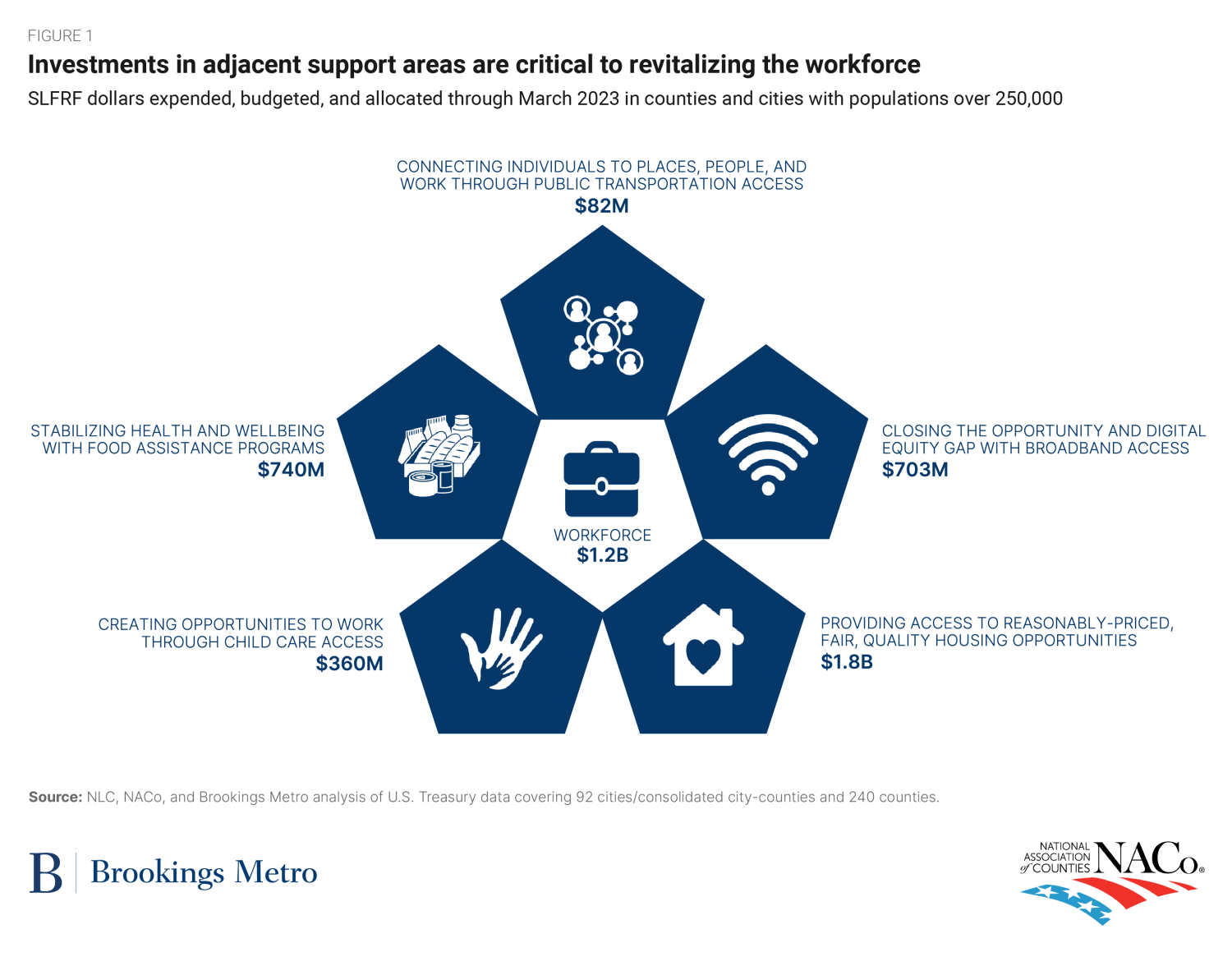Over three years since the start of the COVID-19 pandemic, the U.S. labor market is a more complex landscape than ever, with a historically low national unemployment rate,1 cooling job gains,2 and increased demand across the infrastructure and climate sectors. This mixed picture presents both positives for American workers as well as ongoing challenges.
These trends, along with other factors the pandemic set in motion, have resulted in unusual labor market churn and prompted some individuals to exit it altogether, as reflected in depressed labor force participation rates. Workers are finding that they need additional training or reskilling, as their qualifications and skill sets don’t match available jobs due to the requirements of new employment sectors, a rising degree of digitalization, and other market-driven factors.
Supporting workers’ potential involves skill development, but also broader public investments in workers, families, and communities. Local investments in workforce development and workforce-adjacent programs will position workers toward career trajectories that result in jobs with family-sustaining wages. This pandemic “reset” moment provides opportunities to connect workers to the jobs that can bolster their long-term social and economic mobility.
With U.S. labor markets operating regionally, sub-national strategies that invest in workers’ skills and supports are critical. The American Rescue Plan Act’s (ARPA) $130 billion State and Local Fiscal Recovery Funds (SLFRF) program provides a tremendous resource for local jurisdictions to execute such strategies.3 This includes the $65 billion in direct funding to “Tier 1” cities and counties (those with populations over 250,000), which is the focus of this analysis.
The SLFRF resources represent a flexible and unprecedented opportunity for local jurisdictions to bolster our national workforce infrastructure. Through this opportunity, the U.S. labor recovery reflects a combined story of unique market conditions and targeted local investments in workers to generate long-term opportunities and build a sustainable workforce for the next generation.
Operating within a tight labor market, local leaders nationwide are investing SLFRF resources to connect people in their communities to good jobs and meaningful careers. Moving beyond the initial pandemic-related focus on supporting unemployed individuals and other immediate needs, the landscape has now shifted to local recovery strategies. Alongside other federal programs such as the CHIPS and Science Act, local entities are making investments in workforce development, reskilling programs, and targeted training to prepare workers for the job market of the future.
Localities are leveraging ARPA funds to make significant investments in workforce development and critical workforce-adjacent supports
Data from the Local Government ARPA Investment Tracker—a collaboration between the National Association of Counties, Brookings Metro, and the National League of Cities—illustrates the trends of SLFRF workforce investments.
Large cities and counties (those with populations over 250,000) have invested nearly $1.2 billion in workforce development, including job training programs, tuition stipends, and apprenticeship opportunities. Additionally, local governments have invested $3.6 billion in workforce-adjacent supports such as child care, human service delivery, public transportation enhancements, broadband expansion, and affordable housing. These investments are an unusual and welcome recognition that worker supports can be just as critical for workers and their families as traditional job training and reskilling. (Figure 1).

Counties and cities across the nation have invested in over 1,000 discrete workforce projects across multiple domains, with a focus on skill-building and training for the next generation of employees and coordinating multi-jurisdictional and cross-sector programs. Examples include:
- Workforce development for young people, including almost 100 projects and $225 million for apprenticeships, job training, academic support, and other services. For example, Monroe County, N.Y. invested SLFRF dollars in “The Hive,” a youth workforce consortium that aims to equip teens for entry into mid- and high-wage careers by providing academic support, workforce development, job placement, and behavioral health services.
- Skills-focused training and certifications across 280 projects worth a total of $1.2 billion. For example, the city of Seattle is partnering with the Workforce Development Council of Seattle-King County and the Martin Luther King, Jr. County Labor Council to provide upskilling and reskilling to BIPOC employees in the hospitality sector. Similarly, Prince George’s County, Md. created the Film Business Development and Assistance Initiative, a key component of which is providing apprenticeship programs for residents and addressing equity issues in access to these specialized jobs.
- Workforce participation efforts, such as Franklin County, Ohio’s multi-pronged initiatives, which are supporting on-the-job training, pre-apprenticeships, and youth summer employment programs.
Skills and certifications notwithstanding, job accessibility and opportunity rely on critical components such as transportation, housing stability, broadband reliability, and child care access. Mecklenburg County, N.C. is addressing the gap in child care availability by providing grants to organizations seeking to become licensed providers. Similarly, Gloucester County, N.J. invested in the Pureland East-West Community Shuttle, which connects residents to work opportunities and community supports such as libraries, health facilities, and grocery stores. Revitalizing the workforce requires this type of multi-faceted approach.
The stream of federal resources provides ongoing opportunities for localities to maximize investments in workers
Jurisdictions have until the end of 2024 to obligate their SLFRF dollars and the end of 2026 to spend them. Because many local governments operate on a July budget cycle, we expect the next round of reporting, due in October, to reflect a robust set of SLFRF obligations and projects, though the share of these investments in workforce development will likely remain in line with previous reporting.4
In addition to ARPA funding targeted to workforce development, massive federal programs Congress passed subsequent to ARPA—the Infrastructure Investment and Jobs Act, Inflation Reduction Act, and CHIPS and Science Act—also provide a substantial yet indirect and unassured opportunity for localities to make investments that address emerging demand for the infrastructure and climate workforce.5
Given that localities can unlock additional funding, a sustainable, coordinated, and well-planned investment approach is critical for a workforce in transition. Local leaders know it’s not only about creating new jobs, but connecting residents to high-quality opportunities and augmenting workers’ skill sets to match them. With localities continuing to make ARPA obligations in the second half of 2023, there is a significant opportunity—and need—for continued investments in workforce development by local governments to meet the demands of a changing labor market and, importantly, the workers that are the market’s critical engine.
-
Footnotes
- Unemployment has been below 4% since February 2023.
- U.S. added 209,000 jobs in June 2023 and 187,000 in July 2023.
- SLFRF guaranteed funding to all cities, towns, villages, and counties in the U.S.
- ARPA permits SLFRF recipients to use the dollars to address a wide range of needs in response to the pandemic and its impacts. As of the end of 2022, the 332 large cities and counties we studied had budgeted at least a portion of their flexible funds to more than 11,770 discrete projects. Our organizations analyzed the project data, including “coding” each project into one of seven overall spending groups (community aid; economic and workforce development; government operations; housing; infrastructure; public health; and public safety), and then into 41 spending sub-groups that provide further detail on the use of the funds.
- The CHIPS and Science Act requires private firms to describe their plans to provide affordable child care to their workers in order to receive federal subsidies.






